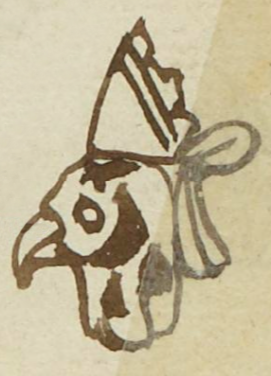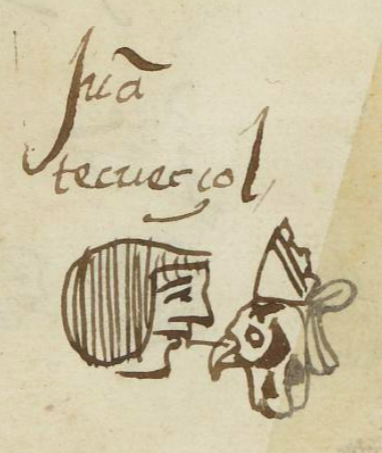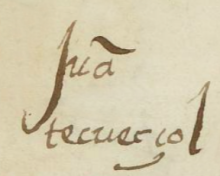Tecuhzol (MH508r)
This black-line drawing of the compound glyph for the personal name Tecuhzol (or perhaps Tecueczol, as it appears in the gloss) features the head of a quail (zolin) in profile, looking toward the viewer's left. On its head is a xiuhhuitzolli, the diadem that serves as the hieroglyph for the title for the lord or high noble, tecuhtli. The diadem is tied at the back. The quail has black markings on its head, and its beak is turned downward.
Stephanie Wood
Since quail did not really wear diadems, perhaps there was a type of quail that appeared to wear a diadem, having an appendage on the top of its head. It may also be that the intention in the name is to refer to something wretched, as the suffix -zol can mean, and the quail head is there as a phonetic indicator. Perhaps the -zolli suffix of xihuitzolli is indicated by the phonetic zolin, and Tecuhzolli is another name for a lord's diadem.
The quail had a role in the religious life of the Nahuas, largely serving as offerings. Their remains are very prevalent in the finds at the Templo Mayor, and they are prominent in the Mixtecs' Codex Nuttall. For further information see Elena Mazzetto, "Quail in the Religious Life of the Ancient Nahuas", en Milbrath, Susan y Elizabeth Baquedano (coords.), 2023, Birds and Beasts of Ancient Mesoamerica. Animal Symbolism in the Postclassic Period, Denver, University Press of Colorado, pp. 200-219.
Stephanie Wood
Juā
tecuecçol
Juan Tecuhzol (or perhaps Tecueczol)
Stephanie Wood
1560
Jeff Haskett-Wood
codornices, quail, birds, pájaros, diadems, diademas, crowns, coronas, señores, teuctli

tecuh(tli), ruler, https://nahuatl.wired-humanities.org/content/tecuhtli
zol(in), quail, https://nahuatl.wired-humanities.org/content/zolin
-zol, wretched or old, https://nahuatl.wired-humanities.org/content/zol
xiuhhuitzolli, turquoise diadem or crown, https://nahuatl.wired-humanities.org/content/xiuhhuitzolli
Matrícula de Huexotzinco, folio 508r, World Digital Library, https://www.loc.gov/resource/gdcwdl.wdl_15282/?sp=95&st=image
This manuscript is hosted by the Library of Congress and the World Digital Library; used here with the Creative Commons, “Attribution-NonCommercial-ShareAlike 3.0 License” (CC-BY-NC-SAq 3.0).





